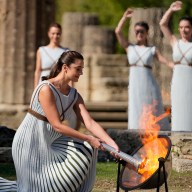WASHINGTON – Sometimes love does feel like it should.
Falling in love can act as a potent painkiller, and now scientists have figured out why: It stimulates the brain’s reward pathway, much like the rush of an addictive drug.
The next question is whether better understanding of the love-pain relationship might somehow help scientists tackle chronic pain. Falling head over heels isn’t exactly something a doctor can prescribe.
But “maybe prescribing a little passion in one’s relationship can go a long way toward helping with one’s chronic pain — assuming it’s passion with the one you’re with,” said study co-author Dr. Sean Mackey, chief of pain management at Stanford University.
The story begins with psychology professor Arthur Aron of the State University of New York at Stony Brook, who studies the neurology of love. His work has linked that euphoric phase of a fresh romance to brain regions rich in the chemical dopamine. Dopamine is key to what’s called the brain’s reward pathway, the feel-good mechanisms that encourage certain behaviours. Eating sweets, for example, boosts this system — and addictive drugs like cocaine hijack it.
“When people are in love, in many ways it’s not dissimilar to what they get when they take amphetamines or stimulants: They’re very excited, have loss of appetite, sleep loss, they’re active, full of energy,” noted Dr. Nora Volkow, director of the National Institute on Drug Abuse and a dopamine expert.
Then pain specialists noticed that if someone in an intense romance gazes at a picture of his or her amour while being poked or prodded, they feel less pain.
Is that because their love is distracting them from the pain? After all, specialists often advise sufferers to listen to music or try other steps to take their mind off the pain. Or did love work some other way? Mackey and Stanford colleague Dr. Jarred Younger teamed with Aron to find out.
They put up campus signs seeking love-struck Stanford undergrads and within hours couples were flocking in, “the easiest study we have ever recruited for in my entire career,” said Mackey.
Fifteen people underwent a battery of tests. They looked at either a picture of their new love or a picture of an attractive acquaintance, or were given distracting tasks such as to list sports that don’t involve balls. Researchers touched them with a hot wand to induce moderate pain, and scanned their brains.
Looking at their loved one and distraction produced equal pain relief — but the distraction worked through cognitive pathways while the romance triggered a surge in that reward pathway, the team reported Wednesday in the journal PLoS One.
That means the brain can generate pain-controlling responses without medications that perhaps, “if we understood them better, we could trigger them,” said NIDA’s Volkow.
Caution: New love’s flush can fade to commitment, which doesn’t trigger the same brain response. But Aron said he recently found that doing something new and exciting with a longtime partner stirs up that old passion, “a good idea whether you’re in pain or not.”













